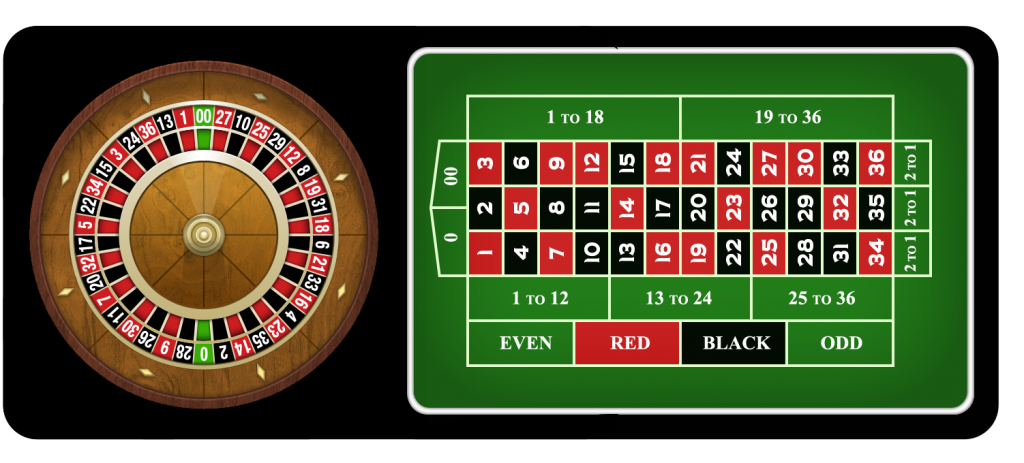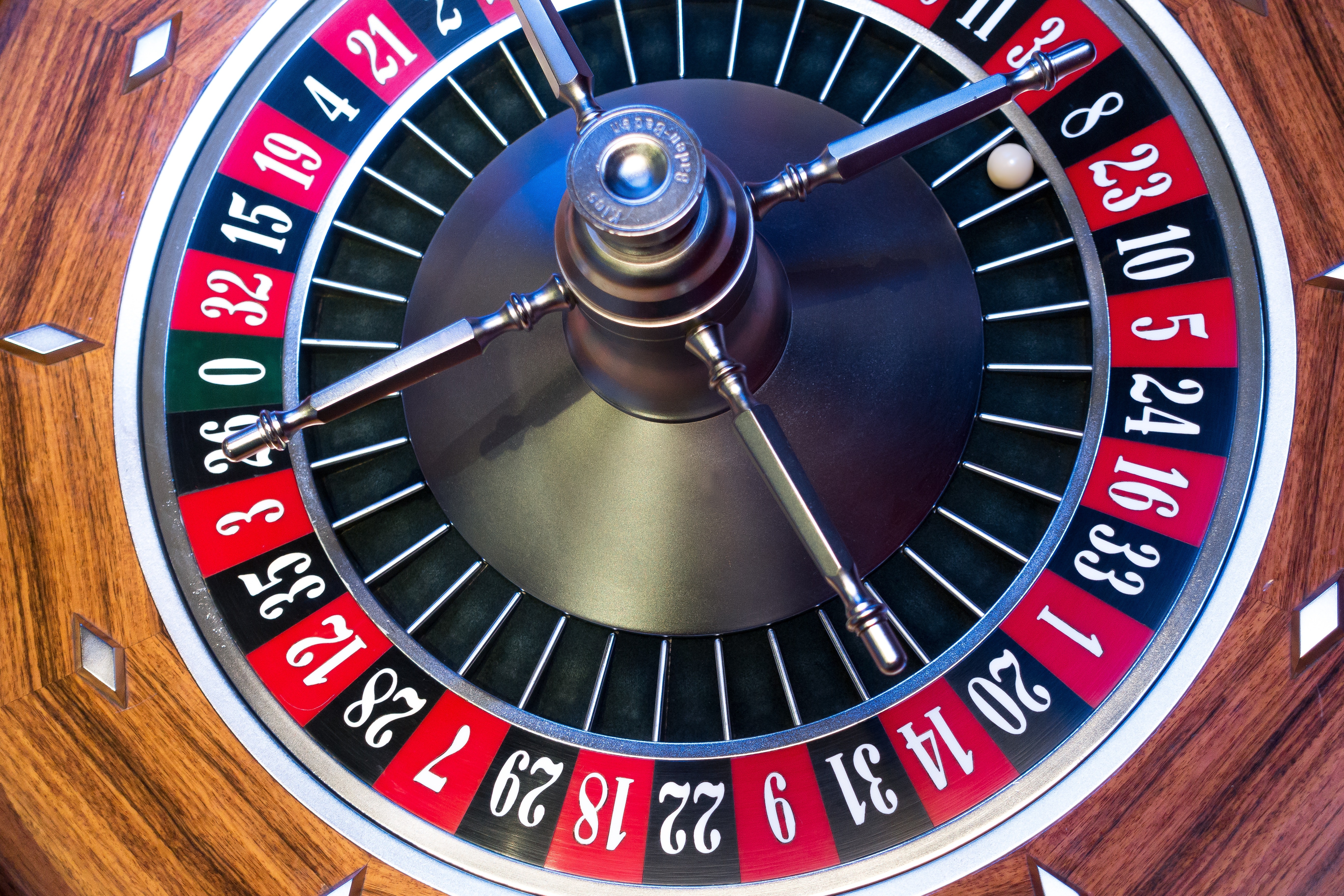Home- Strategy- Probability- Analysis- Test- Quiz|System- Buy- Contact|About
There are 37 numbers on the wheel. There are 18 blacks and 18 reds. Therefore, the winning odds of red are 18/37, which is 0.4865. The odds of black are the same. The same goes for any 'even chance' bet that includes highs and lows, and evens and odds. The odds are not changing, no matter how many times red or black have appeared in a row. If a ball landed in red the last 20 spins in roulette, what is the probability it will land in black the next spin? The same as red, 47.37% on a double-zero wheel, 18 black numbers divided by 38 total numbers. What is the highest roulette odds probability? 48.60% are the odds on a roulette table for a wide range of outside bets. For example, the bets including Even/Odd, Red/Black or Low/High offer the highest odds on roulette with European (48.60%) and American (47.40%) layout. These roulette betting odds mean that your chance to hit a win is almost 50:50.
award winner
Which outcome has a higher probability after eight successive Blacks, Black again or Red? By Jacob Kanzen
Probability, the Martingale system and the 'delayed' double-up betting strategy.
At roulette each spin is a new spin and the outcome is never determined by prior spins. After eight successive blacks, a black is as likely to come up as a red. You may argue that the reds and blacks will eventually even out over a long run, and you would be right. Indeed, we are both right.
Let's first analyse why the odds are the same each spin of the wheel even if the outcomes even out over a long run, and then we'll look at the popular 'delayed' double up betting strategy, based on the Martingale system, that has an apparent probability advantage employed by most beginners. In order to simplify the calculations, we will assume that the roulette wheel has no zeros, just 18 red and 18 black slots.
Consider this:
Roulette Red Or Black Odds Today
In, say, 1,000,000 roulette spins you would have in theory 500,000 reds and 500,000 blacks appearing. Now, we know they don't come up in turns one at a time, that is, you would expect to see two, three, four or more in a row in either colour to appear. For this analysis we will consider the 'eight blacks in a row sequence' as the typical example.
If you were to count all the occurrences of eight blacks in a row FOLLOWED BY A RED, you will find an equal number of occurrences of eight blacks in a row FOLLOWED BY A BLACK (9+ blacks in a row). You will also find an equal number of eight reds in a row in the same way making the total number of blacks and reds equal. If you have a computer roulette simulator, try it out.
This means that of the 'eight blacks' sets there are 50% eight blacks in a row FOLLOWED BY A RED and 50% eight blacks in a row FOLLOWED BY A BLACK. The same applies to the 'eight reds' sets. Therefore if you bet red after eight blacks in a row or if you bet black after eight reds in a row, you will have a 50:50 chance of getting it right.
This is true no matter how many times black or red come up in a row, because for every occurrence of, say, 8, 10 or 20 blacks in a row FOLLOWED BY A RED there will be one with 8, 10 or 20 blacks in a row FOLLOWED BY A BLACK. You just don't know which of the two sequences will come up first.
After eight blacks in a row, your chances of winning are still 50:50 whether you bet on red or black.
Tip: If you are influenced by previous results, then learn to bet with the outcome and not against it. You will eventually realize that it makes no difference. If anything, the 'law of unequal distribution' will be on your side.
The 'delayed' double up betting strategy:
It is a known fact that many players wait for, say, four blacks in a row to appear and then start betting on red doubling up the bet up to four times (or more) if they lose. They do this believing that they have gained a sequential probability advantage - the four successive blacks with no bet. Indeed if you use this strategy, you will win most of the time and you will probably conclude that you have an advantage.
You would be wrong! Take a look at the following figures:
Starting with one chip, if you double up your bet up to four times on red and win, you would win one chip. If you lose on your fourth doubling up bet, you would lose 15 chips (1 + 2 + 4 + 8 = 15). All it takes is one in 16 attempts that you lose and you would have lost all your 15 wins.
Now, try the same double up strategy but bet randomly on red and black. That is, ignore what came up, just bet at will - sometimes red sometimes black and on different tables (switch tables). All you know is this: If you lose you will double up your bet, up to four times. On a long run you should get the same results as your planned one-colour one-table double up betting strategy.
The reason is that it is not the probability of colour that is at work, it is the probability of losing four times in a row on a 50:50 chance bet, which is 1/2 x 1/2 x 1/2 x 1/2 = 1/16. You would in fact in the long run win 15 times and lose one time every 16 attempts, on average. Net profit = 0.
The Martingale system is in fact based on the probability of losing infinite times in a row.


Although infallible in theory, the Martingale system when applied at roulette on the 'even-money' bets requires a large bankroll (it has been reported that in Casino Monte Carlo, Monaco, red came up 39 times in a row), has a very low return and is a very risky one because of the maximum bet limits imposed by the casinos. If you run out of money or reach the house limit, you can lose a lot with no chance to recover your loss.
Tip: For an efficient betting strategy aim to win more money in fewer winning spins.
Two major factors determine how much you win or lose playing roulette. By managing and controlling these two factors, you can generate an advantage that in the long term can make you a winner and keep you ahead of the casino at all times. Find out what these two factors are and what makes a winning system, in the main strategy page titled Winning at Roulette.
Winning at Roulette
Interesting facts, tips and a system.
Home- Strategy- Probability- Analysis- Test- Quiz|System- Buy- Contact|About
Rate this page: Roulette Probability Analysis.
Kanzen's roulette strategies info site
Email: admin@kanzen.com (Jacob Kanzen)
URL: http://www.kanzen.com/analysis.html
Note: This page should show on kanzen.com domain (see the http:// or www. at the top of your browser).
If you are caught inside a 'Frame' of another domain, click here to break out.
Home- Strategy- Probability- Analysis- Test- Quiz|System- Buy- Contact|About
Copyright © Jacob Kanzen See copyright notice.
The most popular bets on the roulette table are Red and Black, this is especially the case in online casinos. Our list of roulette strategies is quite long so what we're going to do here is list all of the different systems that are aimed towards Red and Black betting. It's important to remember that Red and Black have exactly the same odds as Odd/Even and 1-18/19-36 so all of these systems can be used for those bets as well.
The best online casino for Red/Black betting is Royal Panda. Fish hunter gambling game. Their table limits for Red/Black are €0.10 – €10,000 which is one of the widest spreads you'll find online. Play at Royal Panda
The Martingale – This is the most common system that players use. All you do is bet on a colour and then when you lose, you double your next bet. You repeat this process over and over until you get a win. Once you get a win, your overall profit will be whatever bet you started out with. This is one of the riskiest roulette strategies that you can use. Side note – this is a system that can be used all over the roulette table, not just red and black. It is red and black where it is most commonly used though.
Reverse Martingale – This is the exact opposite to the system above. It's know as the Reverse Martingale or the Paroli. Instead of increasing your bets after a loss, you increase them after a win. Palace of chance coupon codes. The hope is that you will get a long streak of the colour that you're betting on and take a big win.
The D'Alembert – This is a steady little strategy that shows better results than flat betting when you get as many wins as losses. As far as roulette strategies go, this is one of the safest. This is a system that can only be used on even chance bets.
Reverse D'Alembert – This is the opposite to the strategy above. The downside to this system is that it requires more wins than losses to be successful.
The Fibonacci – This is a strategy that involves you increasing your bets after a loss like the Martingale but it's safer and it's more steady. Patience and discipline is required with this system.
Reverse Fibonacci – This is the opposite to the strategy above. As with all 'reverse' systems, you need to go on am extended winning run to get a profit.
The Labouchere – This is a strategy that will take a bit of practice to get used to. It's another steady system that is safer than the Martingale and the maths adds up nicely when you use it properly. As with all systems though, a losing run can send your bets too high.
Hollandish Strategy – This is a slow progressive system where you go through 'stages' and each stage has 3 bets.
Oscar's Grind – This is a very similar system to the D'Alembert. You increase your bets after a win and keep them the same after a loss. A slow system that attempts to grind out wins, hence the name.
Odds On Roulette
Whittaker Strategy – This system is almost identical to the Fibonacci. The only real difference is the name.
Royal Panda are a fantastic online casino. They offer numerous roulette games with €0.10 – €200,000 table limits. Better yet, they pay out within 24 hours with no questions asked. Play at Royal Panda

